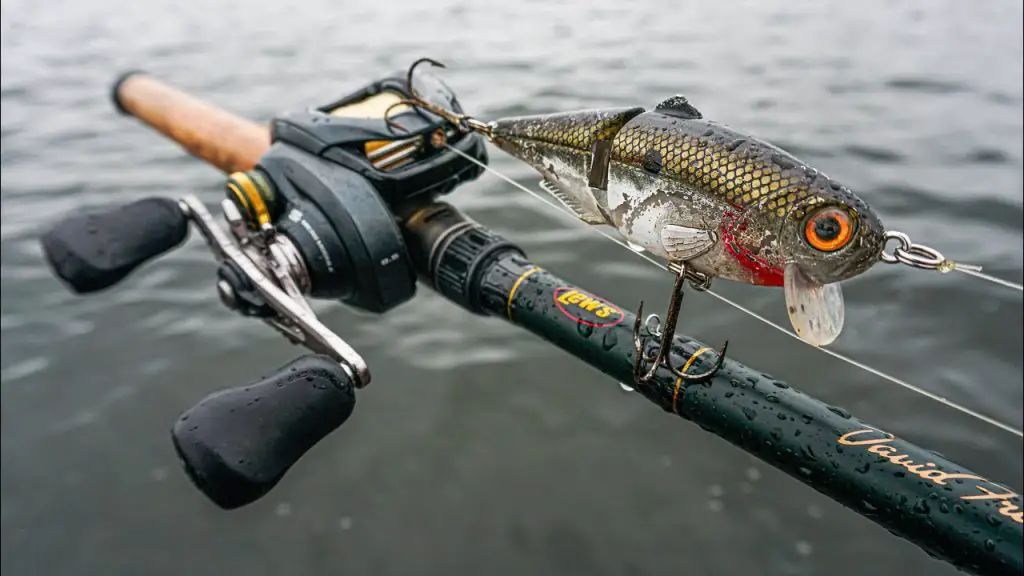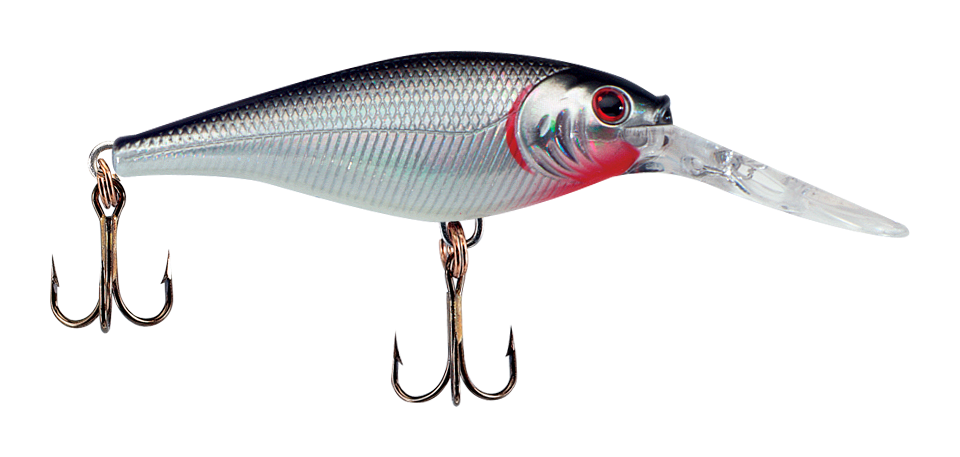The ideal reel speed for crankbait lures is a 5.4:1 to 6.4:1 gear ratio, providing moderate retrieval speed to effectively trigger fish strikes while maintaining control and sensitivity during the retrieve. Experiment with your reel speed to fine-tune your presentation based on the specific fishing conditions.
Crankbaits are one of the most productive lures used to catch bass throughout the year. On the surface, crankbaits might seem like a fairly simple type of lure which you just cast out and reel back in to get a bite. However, a bit more is sometimes necessary if you want to maximize your chances of catching fish.
In this article, I will cover the basics of crankbait fishing and answer the question many anglers want to know: how fast should you reel a crankbait?
| Crankbait Type | Recommended Reel Retrieve Rate (IPT) | Recommended Gear Ratio |
|---|---|---|
| Shallow Diving Crankbaits | 24-32 | 5.4:1 – 6.4:1 |
| Medium Diving Crankbaits | 22-30 | 5.1:1 – 6.2:1 |
| Deep Diving Crankbaits | 20-28 | 4.7:1 – 5.8:1 |
| Lipless Crankbaits | 24-34 | 5.4:1 – 7.0:1 |
| Squarebill Crankbaits | 24-32 | 5.4:1 – 6.4:1 |
| Wakebaits | 18-26 | 4.5:1 – 5.6:1 |
| Jerkbaits | 24-34 | 5.4:1 – 7.0:1 |
Table of Contents
Crankbait Overview
The crankbait is a lure that’s been used to catch fish for more than a century as it was first invented in 1915 by the Creek Chub Bait Company. Professional anglers like Kevin VanDam and David Fritts have made millions of dollars fishing with a crankbait and these anglers will attest that there’s more than one way to fish these incredible lures.
The key to success when using a crankbait involves reaching the depth or water column where the fish are located. To better accomplish this, many crankbait companies produce lures that are billed as a deep diving, medium diving or shallow diving crankbait. There’s also the lipless crankbait, which can be fished deep or shallow depending on how far you allow the lure to fall.
The main question that many anglers ask in regards to crankbaits often have to do with what the best depth is, but the purpose of this article is to answer one particular question that every fisherman wants to know.

How fast should you reel a crankbait?
The answer to this question depends on a number of factors that every angler must take into account if you want to unlock the secrets to catching bass on a consistent basis using crankbaits. In the following sections, I’ll cover the main consensus among professional bass anglers as to how fast you should reel a crankbait depending on the conditions, or at specific times of the year.
Slow Cranking (Winter)
From the fall throughout the winter season, fish mostly focus their feeding efforts on a few specific creatures, which mostly involve shad or small bait fish. Since many of the types of prey that come out in the spring and summer are not available, bass aren’t able to feed on frogs, insects and other creatures as they often want to. Winter forces them to seek out shad, minnows or other types of bait fish in order to survive.
The common consensus on fishing with crankbaits during winter is to reel your lure in very slowly as the fish are often sluggish and unwilling to chase their prey. A slower turn rate of your reel handle might work some of the time, but if you’re really wanting to slow down your retrieve, it’s better to go with a lower gear ratio that offers less inches of line taken up on the spool per turn of the handle. I’ll cover this in more detail later on.
A slow retrieve is not always the case and it should be noted that you can catch both small and big bass by fishing with a smaller crankbait and using a faster retrieve. You can have success with a steady retrieve, but it’s sometimes good to pause the lure now and then when you know you’ve reached a point where fish are staging or sitting near the bottom.
Bass will often target crawfish during winter as they are packed with protein and nutrients that fish need to make it through the cold months. Using a dark or bright red-colored crankbait with a wide wobble will very closely resemble a crawfish swimming through the water.
My typical go-to crankbaits for winter bass fishing include a medium to deep diving lure with flat sides. A flat-sided bait will offer a tight wobble, which is better for winter fishing as it appears more natural in the cold water.
When it comes to how fast you should reel these crankbaits, it will depend on the fish’s activity level on that particular day. It’s true that bass usually prefer a slower retrieve during the winter, but it’s also good to change it up every now and then and use a faster retrieve or pause the lure, especially when you come in contact with underwater structure.
When you think of a faster or slower retrieve with a crankbait, what you should really be considering is whether your crankbait is moving at the right speed underwater, not how fast or slow you’re turning the handle. This speed involves using a reel with the right gear ratio with your crankbait, which I’ll explain in the next section.
Correct Crankbait Reeling Speed
At certain times of the year, successful crankbait fishing comes down to getting your lure to the right depth where fish are located. If you’re not fishing at the right depth, it won’t matter what your reel speed is because you won’t have a chance to get any bites.
Much of the confusion surrounding deep-diving crankbaits and the best way to get them down to the precise depth is tied to the speed at which the angler is reeling the lure. Faster reeling doesn’t always mean deeper diving lures. In some instances, reeling your lure faster will actually have the opposite effect.
A high-speed reel with a gear ratio of more than 7.1:1 is often too fast for deep-diving crankbait fishing at any time of the year. The gear ratio controls the rotation of your spool, not how much line is being retrieved with each turn of the handle. If you want the precise reel speed for crankbait fishing, you’ll need to understand how many inches of line your reel is collecting with each turn of the handle.
According to David Fritts, Bassmaster Classic Champion, the correct crankbait reeling speed is exactly 21 inches of line per turn of the handle. Fritts has said this in his videos, articles and instructional presentations on proper crankbait retrieval speed.
Most baitcasting rod and reel combos that are advertised as “cranking rods” are going to deliver 21 inches of line per turn. If you’re unsure of how much line you’re collecting with each turn of the handle, you can look at the specs on your reel (either on the product packaging or from the company’s website) to get a better understanding of the amount of line it will collect with each turn.
You can speed up or slow down the amount of turns you make with your handle, but this might not always work out. If you’re intending on going with a significantly faster or slower retrieve, the key is not always to turn the handle faster, but to use a different reel with a faster or slower gear ratio and number of line-per-turn rate. This is obviously more expensive and is why you commonly see professional bass anglers with several different rods on the boat deck that are all rigged and ready to cast.
Conclusion
Having the right retrieval speed when fishing with crankbaits involves having confidence that your reel offers the ideal amount of line collected with each turn of the handle. It’s always good to change things up every now and then, so try going with a slightly faster or slower speed to see if it increases the amount of bites you’re getting. Using the points mentioned in this article, you should understand how fast you should reel a crankbait for bass fishing throughout most of the year.

